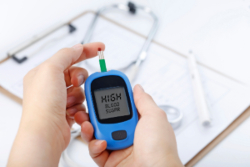High blood sugar levels are a symptom of the metabolic disorder known as diabetes mellitus. Your body can either not utilize the insulin it produces efficiently. Or is not producing enough of the insulin. Your tissues absorb glucose from the blood. And then, store it or use it as fuel thanks to the hormone insulin. Should this not work properly, you might be diabetic.
Diabetes-related high blood sugar that is left untreated can harm your kidneys, eyes, nerves, and other organs. On the other hand, you may safeguard your health by learning about diabetes and taking preventative or therapeutic measures.
Table of Contents
ToggleDiabetes Mellitus Symptoms
Diabetes Mellitus symptoms are triggered by a hike in Blood Sugar Levels. All kinds of diabetes have similar symptoms, even type 1 diabetes, however, they arise over a shorter period than types 2 and 1.5. Type 2 typically has a slower onset. Buzzing nerves and slow-healing wounds are more prevalent in type 2. If neglected, type 1 diabetes can progress to diabetic ketoacidosis. This occurs when the body’s ketones level is dangerously high.
It occurs less frequently in other forms of diabetes, although it is still possible. The next section discusses the multiple types and diabetes mellitus symptoms.
The main signs of diabetes are:
- Weight Loss
- Severe Fatigue
- Unhealing Sores
- Blur Vision
- Frequent Urination
- Increase in Hunger
- Increase in Thurst
Types of Diabetes
Diabetes is classified into multiple types. It includes type 1, 2, 1.5, and gestational diabetes. According to your type, your organs may create insufficient or no insulin, or they may be unable to employ generated insulin efficiently. When any of these s

ituations occur, the body cannot transport sugar from the bloodstream to your cells. This might contribute to high blood sugar levels. Glucose, the type of sugar that circulates the bloodstream, is one of your primary forms of energy. Sugar accumulates in your blood when you don’t have enough insulin or are resistant to it. This can cause health complications.
Type 1 Diabetes
Type 1 diabetes is an immunological disorder. The immune response strikes and destroys pancreatic cells that make insulin. It is unknown what prompted this type. This kind affects approximately 5% to 10% of diabetics. This is because type 1 is most commonly diagnosed in infancy and early adolescence, while it can affect anyone at any point in time.
Type 2 Diabetes
Type 2 diabetes develops when your body grows insulin resistance and sugar accumulates in your bloodstream. Type 2 diabetes is particularly common, accounting for 90% to 95% of all diabetes cases. Type 2 diabetes is most commonly diagnosed in adults, but it can also affect youngsters.
Type 1.5 & Gestational Daibetes
Another name for type 1.5 diabetes in adulthood is latent autoimmune diabetes (LADA). Similar to type 2 diabetes, it develops steadily during maturity. No diet or way of living may cure LADA, an autoimmune condition. Gestational diabetes is an increased level of glucose associated with childbearing.
This kind of diabetes is brought on by substances that the placenta produces that inhibit insulin. After the baby’s delivery, this kind of diabetes typically disappears. Those who have experienced gestational diabetes, however, are more likely to go on to get type 2 diabetes in later life.
Type 1 Diabetes Diet & Causes
Keeping up a balanced diet is crucial for managing Type 1 Diabetes. The goal of a type 1 diabetes diet should be to maximize nutrition while controlling the consumption of fat, protein, and carbs. The things you eat determine how much blood sugar you have in your system. Foods high in sugar or starch cause blood sugar levels to rise quickly. Fat and protein lead to more progressive growth.
It can be advised by your medical staff that you cut back on the quantity of carbohydrates you consume daily. Additionally, you must coordinate your insulin dosages and carbohydrate intake. Keeping track of carbohydrates aids in balancing insulin dosages and consumption.
Type 2 Diabetes Symptoms
It’s usual for type 2 diabetes patients to initially show no symptoms. When symptoms do eventu
ally appear, they can be brought on by high blood sugar or the harm that diabetes can inflict on the organs. Here are some type 2 diabetes symptoms to be aware of if you think you might have it:
- Dry Mouth
- Blur Vision
- Repeated Sores or infections
- Numbness or pain in limbs
- Increased Thirst
- Severe Fatigue
- Frequent Urination
- Mood Swings
- Dark Skin Patches
Most of the type 2 diabetes symptoms are relatively like the other types of diabetes.
What is Diabetic Retinopathy?
A disorder of the eyes called Diabetic Retinopathy causes the blood channels in your retina to deteriorate.
Two varieties of diabetic retinopathy exist:
- Nonproliferative Diabetic Retinopathy
Individuals with the initial phase of the disease have retinal blood vessels that leak. This shows up as either lipid, fluid, or bleeding in the retina.
These vessels will ultimately shut down, leading to ischemia, or insufficient blood supply.
- Proliferative Diabetic Retinopathy
As the illness worsens, aberrant blood vessels enlarge to compensate for the ischemia. These aberrant blood vessels have the potential to bleed blood into the gel-like fluid that fills your eyes.
It causes tractional alterations to the retina’s surface that, in the end, lead the retina to become detached and cause serious vision loss.




